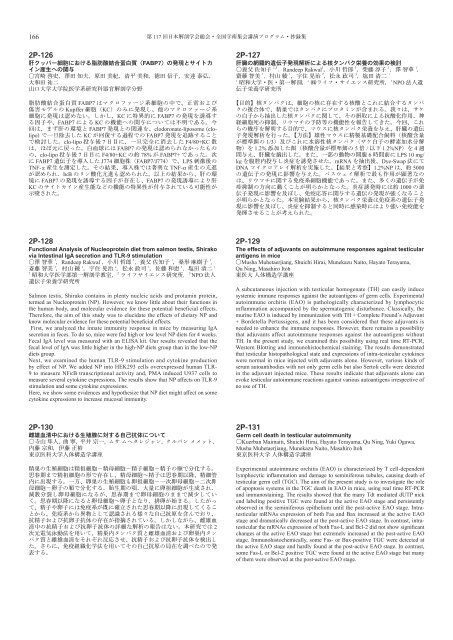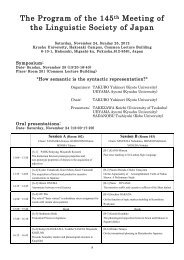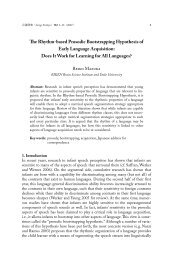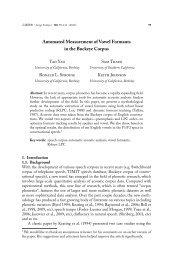第117åæ¥æ¬è§£åå¦ä¼ç·ä¼ã»å ¨å½å¦è¡éä¼ è¬æ¼ããã°ã©ã ã»æé²é PDF ...
第117åæ¥æ¬è§£åå¦ä¼ç·ä¼ã»å ¨å½å¦è¡éä¼ è¬æ¼ããã°ã©ã ã»æé²é PDF ...
第117åæ¥æ¬è§£åå¦ä¼ç·ä¼ã»å ¨å½å¦è¡éä¼ è¬æ¼ããã°ã©ã ã»æé²é PDF ...
Create successful ePaper yourself
Turn your PDF publications into a flip-book with our unique Google optimized e-Paper software.
166<br />
117 <br />
P<br />
FABP<br />
<br />
<br />
<br />
<br />
FABP7 <br />
Kupffer KC<br />
KC FABP7 <br />
FABP7 KC <br />
FABP7 clodoronateliposome clo<br />
lipo KC FABP7 <br />
clolipo 7 F4/80+KC <br />
FABP7 <br />
clolipo 7 F4/80+KC 78% FABP7+ <br />
FABP7 J774 FABP7/J774LPS <br />
TNFα TNFα <br />
IκB <br />
FABP7 FABP7 <br />
KC <br />
<br />
P<br />
<br />
1,3 Randeep Rakwal 1 1 1 1 <br />
1 1 2 3 1<br />
1<br />
2 3 NPO <br />
<br />
<br />
<br />
<br />
<br />
<br />
<br />
1/3<br />
1.2% 5 / 1.2%NP 4 <br />
6 LPS 10 mg/<br />
kg mRNA DyeSwap <br />
DNA 1.2%NP 5000<br />
<br />
<br />
1000 <br />
<br />
<br />
<br />
<br />
P<br />
Functional Analysis of Nucleoprotein diet from salmon testis, Shirako<br />
via Intestinal IgA secretion and TLR stimulation<br />
1 Randeep Rakwal 1 1 1 1 <br />
1 1 2 3 1 1<br />
1<br />
2 3 NPO <br />
<br />
Salmon testis, Shirako contains in plenty nucleic acids and protamin protein,<br />
termed as Nucleoprotein NP. However, we know little about their functions in<br />
the human body, and molecular evidence for these potential beneficial effects.<br />
Therefore, the aim of this study was to elucidate the effects of dietary NP and<br />
know molecular evidence for these potential beneficial effects.<br />
First, we analyzed the innate immunity response in mice by measuring IgA<br />
secretion in feces. To do so, mice were fed high or low level NP diets for 4 weeks.<br />
Fecal IgA level was measured with an ELISA kit. Our results revealed that the<br />
fecal level of IgA was little higher in the highNP diets group than in the lowNP<br />
diets group.<br />
Next, we examined the human TLR9 stimulation and cytokine production<br />
by effect of NP. We added NP into HEK293 cells overexpressed human TLR<br />
9 to measure NFκB transcriptional activity and, PMA induced U937 cells to<br />
measure several cytokine expressions. The results show that NP affects on TLR9<br />
stimulation and some cytokine expressions.<br />
Here, we show some evidences and hypothesize that NP diet might affect on some<br />
cytokine expressions to increase mucosal immunity.<br />
P<br />
The effects of adjuvants on autoimmune responses against testicular<br />
antigens in mice<br />
Musha Muhetaerjiang, Shuichi Hirai, Munekazu Naito, Hayato Terayama,<br />
Qu Ning, Masahiro Itoh<br />
<br />
A subcutaneous injection with testicular homogenate TH can easily induce<br />
systemic immune responses against the autoantigens of germ cells. Experimental<br />
autoimmune orchitis EAO is pathologically characterized by lymphocytic<br />
inflammation accompanied by the spermatogenic disturbance. Classically, the<br />
murine EAO is induced by immunization with TH + Complete Freund’s Adjuvant<br />
+ Bordetella Pertussigens, and it has been considered that these adjuvants is<br />
needed to enhance the immune responses. However, there remains a possibility<br />
that adjuvants affect autoimmune responses against the autoantigens without<br />
TH. In the present study, we examined this possibility using real time RTPCR,<br />
Western Blotting and immunohistochemical staining. The results demonstrated<br />
that testicular histopathological state and expressions of intratesticular cytokines<br />
were normal in mice injected with adjuvants alone. However, various kinds of<br />
serum autoantibodies with not only germ cells but also Sertoli cells were detected<br />
in the adjuvant injected mice. These results indicate that adjuvants alone can<br />
evoke testicular autoimmune reactions against various autoantigens irrespective of<br />
no use of TH.<br />
P<br />
<br />
<br />
<br />
<br />
<br />
<br />
<br />
<br />
<br />
<br />
<br />
<br />
<br />
2<br />
<br />
<br />
<br />
<br />
P<br />
Germ cell death in testicular autoimmunity<br />
Kuerban Maimaiti, Shuichi Hirai, Hayato Terayama, Qu Ning, Yuki Ogawa,<br />
Musha Muhetaerjiang, Munekazu Naito, Masahiro Itoh<br />
<br />
Experimental autoimmune orchitis EAO is characterized by T celldependent<br />
lymphocytic inflammation and damage to seminiferous tubules, causing death of<br />
testicular germ cell TGC. The aim of the present study is to investigate the role<br />
of apoptosis systems in the TGC death in EAO in mice, using real time RTPCR<br />
and immunostaining. The results showed that the many Tdt mediated dUTP nick<br />
end labeling positive TGC were found at the active EAO stage and persistently<br />
observed in the seminiferous epithelium until the postactive EAO stage. Intra<br />
testicular mRNAs expression of both Fas and Bax increased at the active EAO<br />
stage and dramatically decreased at the postactive EAO stage. In contrast, intra<br />
testicular the mRNAs expression of both FasL and Bcl2 did not show significant<br />
changes at the active EAO stage but extremely increased at the postactive EAO<br />
stage. Immunohistochemically, some Fas or Baxpositive TGC were detected at<br />
the active EAO stage and hardly found at the postactive EAO stage. In contrast,<br />
some FasL or Bcl2 positive TGC were found at the active EAO stage but many<br />
of them were observed at the postactive EAO stage.







